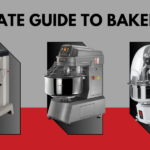Choosing the Right Mixer: The Ultimate Guide to Bakery Mixers
There are tons of mixers out there. And although they all do a great job at mixing, they are not all the right mixer for the job. The bakery industry sees all types of mixers used that vary in terms of capacity, functionality and power. So what are the major differences in each mixer? What are each one used for and what makes them better at mixing certain products than others? These are all great questions and ones we get asked quite frequently. So as a resource for bakers both professional and at home, we decided to create this resource to help educate on which mixer may be right for you!
Planetary Mixer:
This mixer gets its name from the mixing attachments rotation around the bowl in an orbital path, just a like a planet. Planetary mixers come in a variety of capacities for both large wholesale and industrial mixing to smaller retail and even home baking sizes. The strength of these mixers lies in its versatility. Many will come equipped with a standard dough hook, flat beater and wire whisk attachments. These different attachments as well as the various mixing speeds equipped in one of these mixers make them perfect for mixing a wide variety of products. From bread and pastry doughs to creams and batters, Planetary Mixers do a great job mixing many different products. Planetary Mixers are often used in retail bakeries that produce pastries, cookies and cakes due the ability to mix cookie doughs, cake batters and icings on one machine. Most bread professionals will leave their dough mixing to a different style mixer called a Spiral Mixer.
| Perfect For | Not Ideal For |
|---|---|
|
• Cake Batters • Cookie Doughs • Whipped Creams • Frosting • Sauces • Meat Mixtures • Custards |
• Bread Doughs • Liquid-Based Mixtures • High Viscosity Mixtures |
Spiral Mixers:
Spiral Mixers are specifically designed for kneading and folding dough. Although Planetary Mixers can be used for bread dough mixing, they will not do as good of a job as a Spiral Mixer would, and here is why. The spiral arm attachment of a Spiral Mixer properly kneads the dough so that it can achieve proper gluten development. Proper dough consistency and ingredient blending is achieved due to the rotation of not only the spiral arm but the bowl itself. Spiral mixers also help keep the dough at a lower temperature due to the dual rotation of the spiral and bowl. Having your dough get too warm during mixing can negatively affect the gluten development. Artisan breads need to ferment at a slower pace and Spiral Mixers allow that slow ferment during the mixing process to happen.
| Perfect For | Not Ideal For |
|---|---|
|
• Artisan Bread Doughs • Pizza Dough • Bagel Dough • Pretzel Dough • Heavy/Dense Cookie Doughs • Doughnut Dough • Gluten-Free Dough |
• Light Batters • Whipped Mixtures • Small Batch Sizes • Delicate Mixtures |
Diving Arm Mixers
Diving Arm Mixers, also known as fork mixers are a specific type of mixer that offers a unique style of mixing for certain bakery applications. One reason you may choose a Diving Arm Mixer is its gentle mixing ability. The dual arms of this mixer dive into the dough where it is able to gently fold and stretch it. This mixing technique allows for the texture and structure of the dough to be preserved, resulting in a light and airy crumb. Another reason one would choose the Diving Arm Mixer is its hydration control. These mixers are suitable for dough with high hydration levels. This is due to the gentle folding action that help evenly distribute water throughout the dough, promoting hydration without comprising the dough structures integrity.
| Perfect For | Not Ideal For |
|---|---|
|
• High-Hydration Doughs • Doughs with Lower Protein • Longer Mix Times |
• High Viscosity Mixtures • Small Batch Sizes |
Horizontal Mixer
You would most likely only need a Horizontal Mixer in an industrial setting or anywhere else that requires a continuous mixing process. These mixers are capable of producing the largest volume of dough in the shortest amount of time, making them the perfect solution for a production line. As the dough is mixed inside a horizontal mixer, the next batch of dough is fed into the machine, allowing for a continuous mix for constant production. Due to this type of mixing process, dough temperature is usually high without the ability to lower temperature. This makes Horizontal Mixers not the best option for most bread doughs. For large production of bread doughs, there are large capacity and removable bowl spiral mixers. Horizontal Mixers are seen more in facilities that produce short doughs, pie doughs and fillings, cake and muffin batters.
| Perfect For | Not Ideal For |
|---|---|
|
• Cake Batters • Muffin Batters • Pastry Doughs • Cookie Doughs • Cheesecakes • Tortilla Doughs |
• Light Batters • Whipped Mixtures • Small Batch Sizes • Delicate Mixtures |

